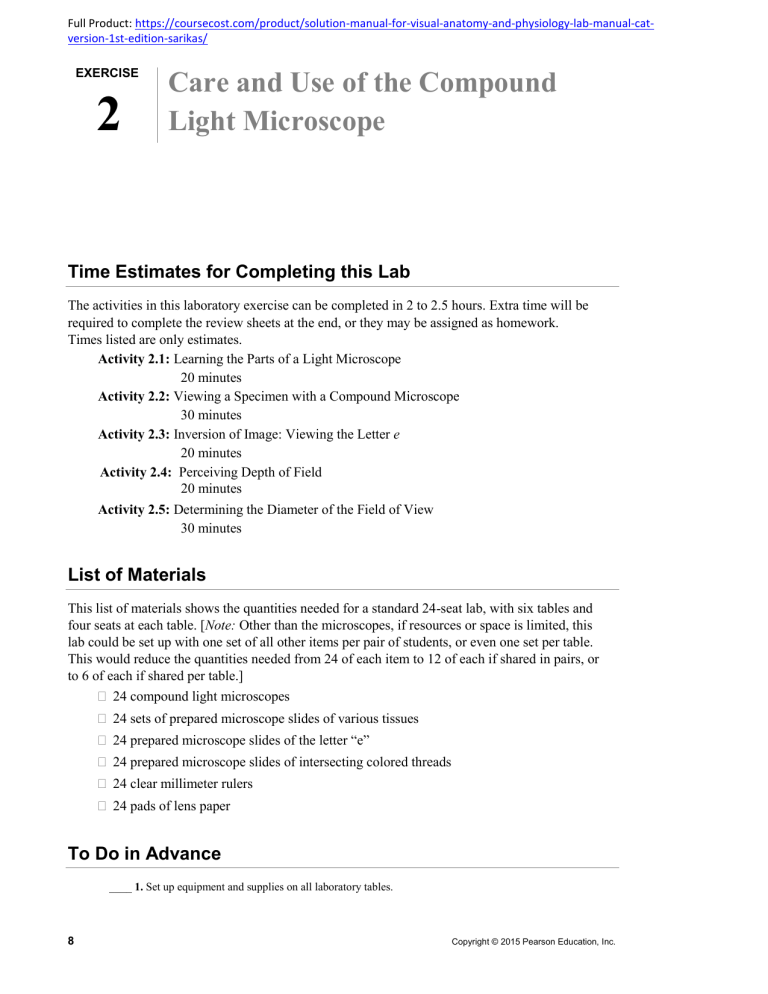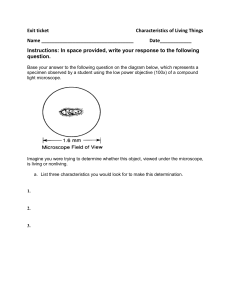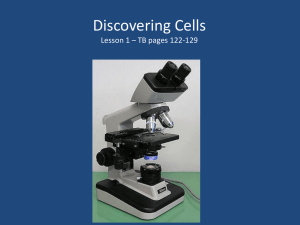
Full Product: https://coursecost.com/product/solution-manual-for-visual-anatomy-and-physiology-lab-manual-catversion-1st-edition-sarikas/
EXERCISE
2
Care and Use of the Compound
Light Microscope
Time Estimates for Completing this Lab
The activities in this laboratory exercise can be completed in 2 to 2.5 hours. Extra time will be
required to complete the review sheets at the end, or they may be assigned as homework.
Times listed are only estimates.
Activity 2.1: Learning the Parts of a Light Microscope
20 minutes
Activity 2.2: Viewing a Specimen with a Compound Microscope
30 minutes
Activity 2.3: Inversion of Image: Viewing the Letter e
20 minutes
Activity 2.4: Perceiving Depth of Field
20 minutes
Activity 2.5: Determining the Diameter of the Field of View
30 minutes
List of Materials
This list of materials shows the quantities needed for a standard 24-seat lab, with six tables and
four seats at each table. [Note: Other than the microscopes, if resources or space is limited, this
lab could be set up with one set of all other items per pair of students, or even one set per table.
This would reduce the quantities needed from 24 of each item to 12 of each if shared in pairs, or
to 6 of each if shared per table.]
24 compound light microscopes
24 sets of prepared microscope slides of various tissues
24 prepared microscope slides of the letter “e”
24 prepared microscope slides of intersecting colored threads
24 clear millimeter rulers
24 pads of lens paper
To Do in Advance
____ 1. Set up equipment and supplies on all laboratory tables.
8
Copyright © 2015 Pearson Education, Inc.
Full Product: https://coursecost.com/product/solution-manual-for-visual-anatomy-and-physiology-lab-manual-catversion-1st-edition-sarikas/
____ 2. Familiarize yourself with the particular model (or models) of microscope your students will be using.
____ 3. Be sure all microscopes are clean and the lowest power objective is in place.
____ 4. Perform Activity 2.4 in advance so you know the correct order of the threads on the particular slides that
your students are using.
Tips and Trouble Spots
Introduction
Take time at the beginning of your laboratory session to discuss the section “Care and
Use of the Compound Microscope” with your students. This step can help you avoid
many problems, including potential damage to both the microscopes and the slides.
You may begin by polling the class to see which students do and do not have
microscope experience. Those lacking experience will require more hands-on guidance
from you while doing the exercise. If you do not regularly check on your students’
progress, they may skip steps or not realize they are not using the equipment appropriately.
If many students are lacking experience, it may be worthwhile to provide a class
demonstration, showing your students the location of the specific parts of the microscope.
Activity 2.1: Learning the Parts of a Light Microscope
Be familiar with the microscopes in your laboratory. They may not have a mechanical stage.
Instead, they may have two movable stage clips. If so, these should be swung out to the side,
the slide positioned between them, then the clips rotated in to secure the slide. Students
should not lift the stage clips as they will become bent and useless with time.
If more than one model of microscope is in use in your lab, be sure students are aware
of any differences and become familiar with them.
Objective lenses may have two numbers stamped on them. The magnification may not
have an “X,” but typical magnifications are 3X or 4X for a scanning objective, 10X for low,
40X to 45X for high, and 100X for oil immersion. Other numbers, if present, are usually DIN
numbers, which refer to the optical standards used for the lens.
Students often have trouble distinguishing between the iris diaphragm and the
condenser lens. They may need assistance with this.
Activity 2.2: Viewing a Specimen with a Compound Microscope
Stress to your students the importance of always starting on the lowest power because they
can more easily locate the specimen and should not (usually) be able to plow through the
slide. Be sure they know to only use the fine-focus adjustment knob when moving to high
power so they do not damage the slide.
Students working with a binocular microscope may need assistance in positioning the two
eyepieces so they get a single image. Watch for students closing one eye and using only one
eyepiece and help them make the needed adjustment.
Activity 2.3: Inversion of Image: Viewing the Letter e
Students may be unclear on how to position the slide on the stage. Tell them to place the slide
so the letter “e” appears as it would if they were reading their book.
Copyright © 2015 Pearson Education, Inc.
EXERCISE 2 Care and Use of the Compound Light Microscope
9
Full Product: https://coursecost.com/product/solution-manual-for-visual-anatomy-and-physiology-lab-manual-catversion-1st-edition-sarikas/
Activity 2.4: Perceiving Depth of Field
Students should be reminded to only use the fine adjustment knob when they move to
high power and to proceed slowly and cautiously. Too often they forget this during this
activity and crack the slide while exploring the order of the three threads.
Colored thread slides from different manufacturers may have the threads in different
orders. Be sure to check the slides your students will be using in advance so you know the
correct order of the threads from top to bottom.
Activity 2.5: Determining the Diameter of the Field of View
Students may be unclear on how to place the ruler through the field of view. Draw or show
an example on the screen or a board so students see the importance of centering the scale to
measure the diameter, and the importance of placing a number at the left edge. Students also
need to be reminded that if the diameter falls between marks on the ruler, they estimate the
additional distance, not just go by the last whole number. Thinner rulers are best for this
activity.
Students get frustrated when moving to high power as they mostly see part of one of the
number marker lines. It becomes almost impossible to estimate millimeters with high
power, but that helps reinforce the need for other units, such as micrometers, for
microscopic measurement.
Exercise 2 Answers
Before You Begin, Consider This…
Answers will vary.
Activity 2.1 Answers
A 1. Answers will vary.
2. One knob moves the stage forward and backward, and the other moves the stage left and
right.
6. Turning the coarse adjustment knob clockwise lowers the stage; turning the knob
counterclockwise raises the stage.
B
10X • 40X = 400X total magnification
MAKING CONNECTIONS: The fine adjustment knob is designed for very precise and very
small changes in focus to bring an already focused object into the sharpest focus, and thus
one complete revolution will barely move the stage. In contrast, the coarse adjustment
knob is designed for rapid initial focusing and thus produces much more movement per
revolution.
Activity 2.2 Answers
C 3. Moving the condenser lens will increase or decrease both the total illumination and
the resolution of the field of view.
D 4. Moving to higher magnification decreases the overall size of the field of view.
Moving to higher magnification decreases the field of view, and thus less light is
seen.
MAKING CONNECTIONS: The entire specimen is illuminated from below. Only the light
passing through the particular part of the specimen in the field of view reaches the eye.
10
INSTRUCTOR’S MANUAL FOR VISUAL ANATOMY & PHYSIOLOGY LAB MANUAL
Copyright © 2015 Pearson Education, Inc.
Full Product: https://coursecost.com/product/solution-manual-for-visual-anatomy-and-physiology-lab-manual-catversion-1st-edition-sarikas/
When moving to higher power, the field of view is reduced. Less of the specimen is
in the field of view, so less light is transmitted.
Activity 2.3 Answers
A 1. e
2. ə
The image is upside down and reversed.
3. As the slide moves to the right, the image appears to move left.
As the slide moves away, the image appears to move closer.
MAKING CONNECTIONS: The image appears to be inverted when viewed through the
microscope—it is upside down and also reversed from side to side. When the slide is
moved in one direction, through the microscope it appears to be moving in the opposite
direction.
Activity 2.4 Answers
A 5. Answers will vary depending on what slides students view.
MAKING CONNECTIONS: Depth of field decreases as magnification increases. The image
is magnified, but the actual diameter of the tube through which the image is viewed is
unchanged, so less of it is visible within that space.
Activity 2.5 Answers
A 6. Magnification data will depend on your particular microscopes, but the most
common values are listed below.
Type of
Magnification
of obj. lens
Magnification
of ocular lens
Total
magnification
Diameter
of the field
of view (mm)
Scanning
4X
10X
40X
Answers will vary
Low power
10X
10X
100X
Answers will vary
High power
40X
10X
400X
Answers will vary
objective
lens
7. The diameter decreases as the magnification increases.
B 1. The magnification of the ocular lens is 10X. If you are using the scanning objective
lens, the total magnification will be 10X times 4X, which equals 40X.
3. Answers vary with the structures selected and the individual estimations each
student makes.
7. Answers will vary.
8. Answers will vary.
MAKING CONNECTIONS: Answers will vary.
Answers to Review Sheet
1. e
2. b
3. f
Copyright © 2015 Pearson Education, Inc.
EXERCISE 2 Care and Use of the Compound Light Microscope
11
Full Product: https://coursecost.com/product/solution-manual-for-visual-anatomy-and-physiology-lab-manual-catversion-1st-edition-sarikas/
4. d
5. c
6. a
7. g
8. h
9. With a parfocal microscope, initial focusing is done rapidly with the scanning
objective or low power objective, where more of the specimen is visible (larger field of
view) so that it can easily be centered. Once the specimen is centered and in focus at
low magnification, the magnification can be increased and the specimen remains
almost in focus so that only the fine adjustment knob needs to be used. This makes it
easier to get the desired object centered and in focus, and it minimizes the risk of
damage to the microscope and the slides.
10. Resolving power is the ability to distinguish close objects as separate and distinct.
11. Working distance is the distance between the slide and the objective lens.
12. The field of view refers to the area of the slide that is visible when viewed through the
microscope.
13.
Low magnification
High magnification
Bigger field of view
Smaller field of view
Greater depth of field
Smaller depth of field
More light transmitted
Less light transmitted
Less detail visible
More detail visible
14. The image will be upside down and reversed left to right.
15. The depth of field refers to the thickness or depth of a specimen that is currently in focus.
16. To determine the diameter of the field of view, use the equation M1D1 = M2D2.
M1D1 = 40X × 5.0 mm = 200 mm
Thus M2D2 must also equal 200 mm. M2 = 100X, so D2 must equal 2.0 mm.
The depth of field at 100X is 2.0 mm.
12
INSTRUCTOR’S MANUAL FOR VISUAL ANATOMY & PHYSIOLOGY LAB MANUAL
Copyright © 2015 Pearson Education, Inc.





